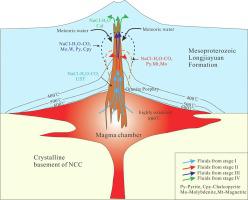当前位置:
X-MOL 学术
›
Ore Geol. Rev.
›
论文详情
Our official English website, www.x-mol.net, welcomes your
feedback! (Note: you will need to create a separate account there.)
Geochronology, geochemistry and fluid inclusions of the Yechangping giant porphyry-skarn Mo-W deposit, East Qinling, China
Ore Geology Reviews ( IF 3.2 ) Pub Date : 2020-12-01 , DOI: 10.1016/j.oregeorev.2020.103823 Tiancheng Zhou , Qingdong Zeng , Shuai Gao , Shaoxiong Chu , Jinhui Yang
Ore Geology Reviews ( IF 3.2 ) Pub Date : 2020-12-01 , DOI: 10.1016/j.oregeorev.2020.103823 Tiancheng Zhou , Qingdong Zeng , Shuai Gao , Shaoxiong Chu , Jinhui Yang

|
Abstract The Yechangping giant porphyry-skarn Mo-W deposit is located in the East Qinling molybdenum belt, Henan Province. Molybdenum mineralization occurs mainly as veins and veinlets or disseminated within dolomite and granite porphyry. The mineralized granite porphyry, emplaced at 148.1 ± 1.0 Ma, has petrological, mineralogical, and geochemical characteristics of I-type granite. The rock belongs to the high-K calc-alkaline to shoshonitic series and is characterized by enrichments in large ion lithophile elements and significant negative Eu, Ba, Sr, P, and Ti anomalies, attributed to strong fractional crystallization. The granite has negative whole-rock eNd(t) values (−13.2 to −12.4) and zircon eHf(t) values (−14.2 to −6.8), corresponding to old whole-rock Nd and zircon Hf model ages, which indicate that the primary magma was derived from partial melting of the ancient lower crust of the North China Craton. Four mineralization stages are identified in the Yechangping deposit. Stage I is a magmatic-hydrothermal transitional stage, which is respresented by the 1–5 mm-wide unidirectional solidification texture (UST), formed from fluids with high temperatures (375–504 °C), high/low salinities (46.3–51.0 vs. 7.81–13.75 wt% NaCl equiv.), and a high oxygen fugacity in an H2O-NaCl-CO2 fluid system. Stage II quartz-K-feldspar stockworks or quartz-K-feldspar-pyrite veins, with minor molybdenite, which are characterized by the K-feldspar and quartz with potassic-quartz alteration; they were formed from fluids with medium-high temperatures (320–464 °C), high/low salinities (38.8–43.4 vs. 5.41–12.85 wt% NaCl equiv.), and a relatively high oxygen fugacity. Stage III quartz-molybdenite stockworks and quartz-molybdenite-polymetallic veins, associated with quartz-sericite alteration, were formed from fluids with medium-low temperatures (273–396 °C), and variable salinities (3.38–40.0 wt% NaCl equiv.). Stage IV quartz-carbonate and fluorite veins, associated with fluid-related argillic alteration were characterized by low temperatures of 171–245 °C and low salinities of 3.23–8.00 wt% NaCl equiv.. The prolonged fractional crystallization, the high oxidization state of the magmatic-hydrothermal system and the fluid boiling process were the key factors that have contributed to the formation of the Yechangping giant Mo-W deposit.
中文翻译:

东秦岭叶场坪巨型斑岩-矽卡岩钼钨矿床年代学、地球化学及流体包裹体
摘要 叶昌坪巨型斑岩-矽卡岩钼钨矿床位于河南省东秦岭钼矿带。钼矿化主要以脉和细脉形式出现,或散布在白云岩和花岗岩斑岩中。矿化花岗岩斑岩位于 148.1±1.0 Ma,具有 I 型花岗岩的岩石学、矿物学和地球化学特征。该岩石属于高钾钙碱性至钾长石系列,以大离子亲石元素富集和显着的负Eu、Ba、Sr、P和Ti异常为特征,归因于强烈的分异结晶。花岗岩具有负的全岩 eNd(t) 值(-13.2 至 -12.4)和锆石 eHf(t) 值(-14.2 至 -6.8),对应于旧的全岩 Nd 和锆石 Hf 模型年龄,表明原生岩浆来源于华北克拉通古下地壳的部分熔融。在叶场坪矿床中确定了四个成矿阶段。第一阶段为岩浆-热液过渡阶段,以 1-5 mm 宽的单向凝固织构(UST)为代表,由高温(375-504 °C)、高/低盐度(46.3-51.0与 7.81–13.75 wt% NaCl equiv.),以及在 H2O-NaCl-CO2 流体系统中的高氧逸度。Ⅱ期石英-钾长石矿床或石英-钾长石-黄铁矿脉,含少量辉钼矿,特征为钾长石和石英带钾-石英蚀变;它们由具有中高温 (320–464 °C)、高/低盐度(38.8–43.4 vs. 5.41–12.85 wt% NaCl 当量)的流体形成,和相对较高的氧逸度。与石英-绢云母蚀变有关的 III 期石英-辉钼矿厂和石英-辉钼矿-多金属矿脉是由中低温(273-396°C)和可变盐度(3.38-40.0 wt% NaCl 当量)的流体形成的。 )。与流体相关的泥质蚀变相关的 IV 期石英-碳酸盐和萤石脉的特征是 171–245 °C 的低温和 3.23–8.00 wt% NaCl 当量的低盐度。岩浆-热液系统和流体沸腾过程是叶场坪巨型钼钨矿形成的关键因素。由中低温(273–396 °C)和可变盐度(3.38–40.0 wt% NaCl 当量)的流体形成。与流体相关的泥质蚀变相关的 IV 期石英-碳酸盐和萤石脉的特征是 171–245 °C 的低温和 3.23–8.00 wt% NaCl 当量的低盐度。岩浆-热液系统和流体沸腾过程是叶场坪巨型钼钨矿形成的关键因素。由中低温(273–396 °C)和可变盐度(3.38–40.0 wt% NaCl 当量)的流体形成。与流体相关的泥质蚀变相关的 IV 期石英-碳酸盐和萤石脉的特征是 171–245 °C 的低温和 3.23–8.00 wt% NaCl 当量的低盐度。岩浆-热液系统和流体沸腾过程是叶场坪巨型钼钨矿形成的关键因素。
更新日期:2020-12-01
中文翻译:

东秦岭叶场坪巨型斑岩-矽卡岩钼钨矿床年代学、地球化学及流体包裹体
摘要 叶昌坪巨型斑岩-矽卡岩钼钨矿床位于河南省东秦岭钼矿带。钼矿化主要以脉和细脉形式出现,或散布在白云岩和花岗岩斑岩中。矿化花岗岩斑岩位于 148.1±1.0 Ma,具有 I 型花岗岩的岩石学、矿物学和地球化学特征。该岩石属于高钾钙碱性至钾长石系列,以大离子亲石元素富集和显着的负Eu、Ba、Sr、P和Ti异常为特征,归因于强烈的分异结晶。花岗岩具有负的全岩 eNd(t) 值(-13.2 至 -12.4)和锆石 eHf(t) 值(-14.2 至 -6.8),对应于旧的全岩 Nd 和锆石 Hf 模型年龄,表明原生岩浆来源于华北克拉通古下地壳的部分熔融。在叶场坪矿床中确定了四个成矿阶段。第一阶段为岩浆-热液过渡阶段,以 1-5 mm 宽的单向凝固织构(UST)为代表,由高温(375-504 °C)、高/低盐度(46.3-51.0与 7.81–13.75 wt% NaCl equiv.),以及在 H2O-NaCl-CO2 流体系统中的高氧逸度。Ⅱ期石英-钾长石矿床或石英-钾长石-黄铁矿脉,含少量辉钼矿,特征为钾长石和石英带钾-石英蚀变;它们由具有中高温 (320–464 °C)、高/低盐度(38.8–43.4 vs. 5.41–12.85 wt% NaCl 当量)的流体形成,和相对较高的氧逸度。与石英-绢云母蚀变有关的 III 期石英-辉钼矿厂和石英-辉钼矿-多金属矿脉是由中低温(273-396°C)和可变盐度(3.38-40.0 wt% NaCl 当量)的流体形成的。 )。与流体相关的泥质蚀变相关的 IV 期石英-碳酸盐和萤石脉的特征是 171–245 °C 的低温和 3.23–8.00 wt% NaCl 当量的低盐度。岩浆-热液系统和流体沸腾过程是叶场坪巨型钼钨矿形成的关键因素。由中低温(273–396 °C)和可变盐度(3.38–40.0 wt% NaCl 当量)的流体形成。与流体相关的泥质蚀变相关的 IV 期石英-碳酸盐和萤石脉的特征是 171–245 °C 的低温和 3.23–8.00 wt% NaCl 当量的低盐度。岩浆-热液系统和流体沸腾过程是叶场坪巨型钼钨矿形成的关键因素。由中低温(273–396 °C)和可变盐度(3.38–40.0 wt% NaCl 当量)的流体形成。与流体相关的泥质蚀变相关的 IV 期石英-碳酸盐和萤石脉的特征是 171–245 °C 的低温和 3.23–8.00 wt% NaCl 当量的低盐度。岩浆-热液系统和流体沸腾过程是叶场坪巨型钼钨矿形成的关键因素。











































 京公网安备 11010802027423号
京公网安备 11010802027423号